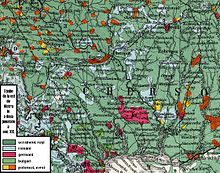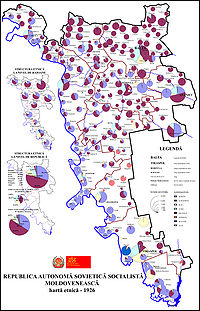- Demographic history of Transnistria
-
A demographic history of Transnistria shows that actual Transnistria has been home to numerous ethnic groups, in varying proportions, over time. Until the early 19th century, it was sparsely populated. In the last centuries most of the population is romanian/moldavian.
Contents
Ethnicity prior to 1792
The word "Transnistria" means literally lands beyond the Dniester river (this river is called "Nistru" in romanian/moldavian) and these lands are historically related to the neo-latin populations that lived east of Bessarabia. Indeed actual Transnistria is only a small area of these lands, and the most western: Transnistria historically reached during World War II the Bug river, while ethnic Moldavians/Romanians moved to live even near the Don river in 1712.
In the coastal area of these lands, during the Roman empire there were small cities of nearly 5,000 inhabitants like Tyras and Olbia, where Roman colonists settled under the protection of Roman legionaries. The interior was sparsely populated by barbarians and for many reasons all the region between the Dniester and the Bug river for centuries -during the middle ages- remained a nearly desert steppe, continuously raided by invasions.
Beside the droughty periods typical for the region, the second reason for the underpopulation of the Black Sea northern shores is the vicinity of the Tatars. Their presence, both military and civil, impeded the settling of the east European type life and blocked the Moldavian or even Polish expansion to the east. The Transnistrian lands settled in the Middle Ages by Romanians were only partially and temporarily ruled by Moldavian princes or possessions of the Moldavian Principality. Probably those Moldavians living east of the Dniester were only a few thousands.
Many Romanians lived even farther east in the steppe lands of Transnistria (Land over Nistru), scattered (mainly) in small rural settlements. Transnistria was in the past an arid, underpopulated region that began to be colonized in the Middle Ages (after 1500, probably, but possibly even earlier) by Moldavians that crossed the Nistru river in search of free land and by some Tartars, its borders not being delimited as for a distinctive entity, a part of something. The eastern frontier was for Moldavia rather theoretical than effective up to the 19th century.In the east of river Nistru the Romanian life is mentioned all over the Middle Age.The oldest attested Moldavian possession over the Dniester River was the Lerici castle (at the entrance inside Dnieper's estuary, where the fortress Ochakov was later on to be built), captured by some Moldavian pirates from the Genoese in the times of voivod Petru Aron (in 1455).[1]The steppe around the Bug river was mostly depopulated in the XIII and XIV centuries because of the Golden Horde, according to some travelers (like in the "Chorographia Moldaviae" of Georg Reicherstorfer, written in 1541). They found there only some Vlach shepherds and a few Moldavian and Slav villages.
Meanwhile the Romanian/Moldavian colonization east of Bessarabia -that had started around the year 1000 AD- had reached the Kiev area in the XV century and in 1712 even the Don river, with the Dimitrie Cantemir leadership[2]
Ethnically the area of Transnistria between the Dniester and the Bug river -even if depopulated- was probably 2/3 moldavian speaking (while between the Bug and the Dnieper most of the population was slav), when Russia started to conquest it. Indeed, according to the results of the census (quoted in Romanian sources) of 1793 AD, 49 villages out of 67 between the Dniester and the Bug were Romanian.[3]
Russian Empire period (1792 - 1917)
In 1792, the whole Transnistria became part of the Russian Empire. At that time, the population was sparse and the Russian Empire encouraged large migrations into the region, including ethnic Ukrainians, Romanians, Russians and Germans.
Russia began attempting to lure Romanian settlers (mostly from Moldavia, but also from Transylvania, Bukovina and Muntenia) to settle in its territory in 1775, after it gained the largely uninhabited territory between the Dnieper and the Bug.[4] But the colonization was to a larger scale after 1792, to Transnistria and beyond, when the Russian government declared that the region between the Dniester and the Bug was to become a new principality named "New Moldavia", under Russian suzeranity.[5]
After 1812 Russia annexed Bessarabia (located west of the Dniester and up to the Prut river), while a process of russification started to be done with the moldavian/romanian populations east of the Dniester.
Soviet and post-Soviet periods (1917 to present)
Since the Soviet era, Transnistria is home to three major groups: Moldovans forming a plurality alongside Russians and Ukrainians.
Historically, after one century of russification, the Moldovans were no more the majority of population in the areas of Soviet MASSR (Moldavian Autonomous Soviet Socialist Republic) established in 1924. MASSR was limited to some areas east of the Dniester, until Balta. East of Balta, most of the romanians/moldavians -settled there since the end of Tartar attacks in the XVI century- were already "assimilated" by the slavs in the early XX century (but there were nearly 100,000 moldovan speaking living east of the MASSR and up to the Dnieper river[6]).
According to the 1926 Soviet census, the Republic had a population of 572,339,[7] of which:
Ethnic
groupcensus 1926 1936 Number % Number % Ukrainians 277,515 48.5% 265,193 45.5% Moldovans 172,419 30.1% 184,046 31.6% Russians 48,868 8.5% 56,592 9.7% Jews 48,564 8.5% 45,620 7.8% Germans 10,739 1.9% 12,711 2.2% Bulgarians 6,026 1.1% Poles 4,853 0.8% Roma (Gypsies) 918 0.2% Romanians 137 0.0% Other 2,300 0.4% 13,526 2.4% Total 572,339 582,138 Despite this relatively extensive territory allotted to the Moldavian Autonomous Soviet Socialist Republic, more than 85,000 Moldovans remained in Ukraine (and Soviet Russia) outside the territory of MASSR.
When Romania created the Governorate of Transnistria in 1941 during World War II, most of the population was ukrainian/russian and only nearly 10% was romanian. The main reason of this was that all the area from the Dniester up to the Bug (that historically was part of the Yedisan territory of the expelled Nogais) was included in this fascist "Greater Romania".
In this way, from 1941 to 1944 the Romanian "irredentism" had obtained the union of nearly 200,000 ethnic Romanians to their motherland, even if with the loss of Transylvania to Hungary. Even Odessa was subject to Romanian administration, as the city had been made part of Transnistria.[8]
In December 1941 Romanian authorities conducted a census in Transnistria, and the ethnic structure was the following:
Ethnicity Number % Rural Urban Ukrainians 1,775,273 76.3 79.9 57.4 Romanians 197,685 8.4 9.3 4.4 Russians 150,842 6.5 2.4 27.9 Germans 126,464 5.4 5.9 2.7 Bulgarians 27,638 1.2 1.1 1.4 Jews 21,852 0.9 0.7 2.0 Poles 13,969 0.6 0.3 2.3 Lipovens 968 - - 0.1 Tatars 900 - - 0.1 Others 10,628 0.5 10.2 1.7 Total 2,326,224* 100 1,956,557 369,669 When the Soviet reconquered the area in 1944, they created the Moldavian Soviet Socialist Republic with former MASSR included, where ethnic Moldovans were the majority.
Evolution of the population and the ethnic composition of Moldavian SSR, 1940-1989[9][10] ethnic group 1941 1959 1970 1979 1989 Moldavians 1,620,800 68.8% 1,886,566 65.4% 2,303,916 64.6% 2,525,687 63.9% 2,794,749 64.5% Romanians - - 1,663 0.06% 1,581 1,657 2,477 0.06% Ukrainians 261 200 11.1% 420,820 14.6% 506,560 14.2% 560,679 14.2% 600,366 13.8% Russians 158,100 6.7% 292,930 10.2% 414,444 11.6% 505,730 12.8% 562,069 13.0% Jews - - 95,107 3.2% 98,072 2.7% 80,127 2.0% 65,672 1.5% Gagauz 115,700 4.9% 95,856 3.3% 124,902 3.5% 138,000 3.5% 153,458 3.5% Bulgarians 177,700 7.5% 61,652 2.1% 73,776 2.1% 80,665 2.0% 88,419 2.0% Gypsy - - 7,265 0.2% 9,235 0.2% 10,666 0.3% 11,571 0.3% others 23,200 1.0% 22,618 0.8% 43,768 1.1% 48,202 1.2% 56,579 1.3% Total 2,356,700 2,884,477 3,568,873 3,949,756 4,335,360 Note: "-" means the official census data does not identify that group in that year, i.e. counts it within other groups, not that the group is not present.
In the first year of the latter half of the 20th century, the ethnic proportions have changed in large measure due to industrialization and the immigration of Russian and Ukrainian workers, encouraged by Stalin. During the Soviet rule, up to one million people settled in Moldova.
The trend continued after 1991, too, as the Moldovan population in Transnistria decreased between 1989 and 2004 from 39% to 32% of the total population. However, the Moldovans are still the largest single group of the Transnistria region (followed by the Russians).
Ethnicity 1926 census 1936 census 1989 census 2004 census Moldovans 44.1% 41.8% 39.9% 31.9% Ukrainians 27.2% 28.7% 28.3% 28.8% Russians 13.7% 14.2% 25.5% 30.4% Jews 8.2% 7.9% 6.4% Bulgarians 6.8% 7.4% 2.5% Poles 2% Gagauz: 0.7% Belarusians 0.7% Germans 0.4% Others 4.6% Moldovans (Romanians) are the most numerous ethnic group, representing an overall majority in the two sub-districts in the central Transnistria (Dubăsari sub-district, 50.15%, and Grigoriopol sub-district, 64.83%), a 47.82% relative majority in the northern Camenca sub-district, and a 41.52% relative majority in the southern (Slobozia sub-district). In Râbniţa sub-district they are a 29.90% minority, and in the city of Tiraspol, they constitute a 15.24% minority of the population.
Russians are the second numerous ethnic group, representing a 41.64% relative majority in the city of Tiraspol, a 24.07% minority in Slobozia, a 19.03% minority in Dubăsari, a 17.22% minority in Râbniţa, a 15.28% minority in Grigoriopol, and a 6.89% minority in Camenca.
Ukrainians are the third numerous ethnic group, representing a 45.41% relative majority in the northern Râbniţa sub-district, a 42.55% minority in Camenca, a 32.97% minority in Tiraspol, a 28.29% minority in Dubăsari, a 23.42% minority in Slobozia, and a 17.36% minority in Grigoriopol.
See also
- 1989 Census in Transnistria
- 2004 Census in Transnistria
- History of Transnistria
- Demographics of Moldova
References
- ^ Moldavians in middleages Transnistria
- ^ Map showing Romanian/Vlach colonists in Ukraine
- ^ E. Lozovan, Romanii orientali…(Eastern Romanians…), ,,Neamul Romanesc”, 1/1991, p.32. via Vlachs/Romanians east of the Dniester river and up to the Bug river area
- ^ Nistor, Vechimea..., p. 14
- ^ Nistor, Vechimea..., p. 16
- ^ Dallin, Alexander. Odessa, 1941-1944: A Case Study of Soviet Territory Under Foreign Rule.Chapter 2. Note # 113
- ^ Nistor, Vechimea... p.4; King, p. 54
- ^ Odessa population during WWII
- ^ V.V. Kembrovskiy, E.M. Zagorodnaya, "Naselenie soyuznyh respublik", Moscow, Statistika, 1977, p. 192
- ^ Soviet 1959, 1970, 1979, and 1989 population censa.
External links
Demographic history of Europe Sovereign
states- Albania
- Andorra
- Armenia
- Austria
- Azerbaijan
- Belarus
- Belgium
- Bosnia and Herzegovina
- Bulgaria
- Croatia
- Cyprus
- Czech Republic
- Denmark
- Estonia
- Finland
- France
- Georgia
- Germany
- Greece
- Hungary
- Iceland
- Ireland
- Italy
- Kazakhstan
- Latvia
- Liechtenstein
- Lithuania
- Luxembourg
- Macedonia
- Malta
- Moldova
- Monaco
- Montenegro
- Netherlands
- Norway
- Poland
- Portugal
- Romania
- Russia
- San Marino
- Serbia
- Slovakia
- Slovenia
- Spain
- Sweden
- Switzerland
- Turkey
- Ukraine
- United Kingdom
- (England
- Northern Ireland
- Scotland
- Wales)
States with limited
recognition- Abkhazia
- Kosovo
- Nagorno-Karabakh
- Northern Cyprus
- South Ossetia
- Transnistria
Dependencies
and other territories- Åland
- Faroe Islands
- Gibraltar
- Guernsey
- Jan Mayen
- Jersey
- Isle of Man
- Svalbard
Other entities Categories:- Economy and Society of Transnistria
- History of Transnistria
- Demographics of Moldova
Wikimedia Foundation. 2010.






